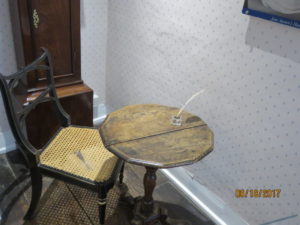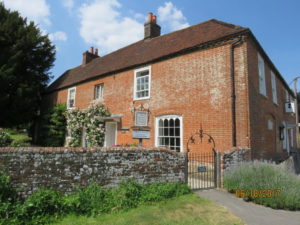
In a time before phones, email, text messages, and social media, Regency ladies and gentlemen had only one way of keeping in touch with friends and family too far distant to see frequently; they wrote letters. The upper classes took their writing very seriously, and often wrote long, detailed letters to family and friends. Many also wrote religiously in their journals. And, of course, poets, authors, and anyone who kept books or ledgers needed reliable writing instruments.
Necessary writing tools included quill pens, an inkstand or inkwell filled with ink, a pen knife, and sand or blotters. Often these implements were stored together in a little box inside a desk.
Looking at the process through the lens of our modern eye, it is easy to overlook the pen knife. Yet it is as essential as the pen and ink for anyone who wanted to write. Quill pens, which were usually goose quills (but could also be from peacock, swan, or even crow feathers) always needed sharpening, trimming, and shaping, just as today’s pencils need sharpening. Pen knives could also be used to sharpen the pencil, which had only been in use since the 1700’s, as opposed to the quill pen that people had been using for centuries.
Cutting a quill pen took a great deal of skill. The nib had to be carefully shaped in order for the hollow core to hold the correct amount of ink, and then be released smoothly as the writer pressed on it. I found detailed instructions about how to sharpen a quill here.
Many quills were kept together in a little box. I suspect if one planned to do a lot of writing, one sharpened the quills all at once, then in the course of their writing, simply set aside a flattened or misshapen quill and picked up another from the box without losing the rhythm of writing.
In Pride and Prejudice, the proud yet fawning Caroline Bingley offered to mend Mr. Darcy’s pen, adding that she mended pens “remarkably well.” It must have been an admirable skill if she felt to boast about it to the gentlemen she hoped to snare as her husband.

Pen knives could be ornate, made of expensive materials such as agate or ivory or mother-of-pearl. They were often gilded or encrusted with precious metals and even jewels. These were purchased from a jeweler. Plainer styles which came from the stationers had wooden handles and were merely sanded and polished, without adornment.
For hundreds of years, pen knives had a blade that was fixed in the handle. During the 1700’s pen knives could be folded, like today’s pocket knife.
In Jane Austen’s Mansfield park, Fanny Price’s two younger sisters fight over a silver pen knife which had been a gift from the godmother of a dead sister. The sister had handed the knife to Susan before she died.
To the right is a photo I took while visiting the home of Jane Austen in Chawton, now a museum. I can so easily imagine picturing her here writing her novels and her letters, can’t you?
Pen knives had other uses. Many new few books were uncut at top and front. They had to be sliced open so one could read the book. A sharp knife was needed to keep the pages from tearing. I suspect the wealthy had a knife specifically used for this purpose, and did not double up using the precious pen knife, but the average person probably had to made do with an all-purpose knife.
Pen knives were as important to a Regency household as pencil sharpeners are to an elementary student today.

To the left is a photo of the house where she lived so happily with her mother and beloved sister, Cassandra, and did so much writing.
I found the images of pen knives that you may wish to view here, and here.

I have a few old inkbottles. One is stonewear. I also used to have a mother of pearl pen with a nib. I wonder where I put it!
How wonderful! If you find them, please take photos. I’d love to see them!
I love reading your historical information! Several months ago, my husband and I visited London. He asked if I wanted to eat at the new Sexy Fish restaurant. I declined thinking it was just a new trendy restaurant. Then I came home and read your blog about it being Gunters! Ahhhhhh! We just have to go back!
That’s funny! I refused to eat there just to protest the change 🙂
Thank you for the information on Pen Knives. I always wondered about that scene between the two sisters in Mansfield Park.
I was born in London and raised in Huntingdon, Cambridgeshire. If you ever do go to London go eat at a piemash shop. Yummy.